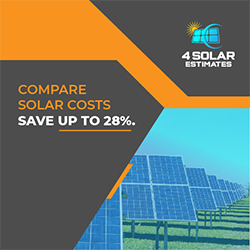
How Long Can You Expect Solar Panels to Last? A Comprehensive Guide to Solar Panel Lifespan
Solar panels have become increasingly popular as a sustainable and cost-effective solution for generating electricity. If you’re considering investing in solar panels for your home or business, you may be wondering about their lifespan and the long-term benefits they can provide. In this blog, we’ll explore the different types of solar panels, their expected lifespans, and the factors that can impact their longevity.
COMPARE SOLAR QUOTESTypes of Solar Panels and Their Expected Lifespans
There are three main types of solar panels: monocrystalline, polycrystalline, and thin film. Each type has its own unique characteristics and lifespan expectations:
Monocrystalline Solar Panels
Monocrystalline solar panels are made from a single crystal structure, providing the highest efficiency among the three types. These panels are known for their sleek appearance and longevity. The expected lifespan of monocrystalline solar panels is between 25 and 35 years, with some high-quality panels lasting even longer.
Polycrystalline Solar Panels
Polycrystalline solar panels are made from multiple crystal structures and are slightly less efficient than monocrystalline panels. However, they are more affordable and still offer a reliable energy solution. The expected lifespan of polycrystalline solar panels is around 25 to 30 years, making them a solid long-term investment for many homeowners and businesses.
Thin-Film Solar Panels
Thin-film solar panels are made from a variety of materials, including amorphous silicon, cadmium telluride, and copper indium gallium selenide. These panels are lightweight, flexible, and generally less expensive than their crystalline counterparts. However, they are also less efficient and have a shorter lifespan, typically lasting between 10 and 20 years.

Factors Affecting Solar Panel Lifespan
Several factors can impact the longevity of solar panels, including:
- Quality of Materials and Manufacturing
High-quality materials and manufacturing processes are essential for producing durable and long-lasting solar panels. Investing in well-made panels from reputable manufacturers can help ensure a longer lifespan for your solar energy system.
- Installation and Mounting
Proper installation and mounting are crucial for the longevity of your solar panels. Poorly installed panels can be more susceptible to damage from weather and other external factors, potentially reducing their lifespan. Always work with a reputable installer to ensure your panels are correctly installed and secure.
COMPARE SOLAR QUOTES- Maintenance and Cleaning
Regular maintenance and cleaning can help prolong the life of your solar panels. Removing dirt, debris, and snow from the panels can prevent damage and ensure they continue to function efficiently. Most solar panel manufacturers recommend annual inspections and cleaning to maintain optimal performance.
- Environmental Conditions
Environmental factors, such as extreme temperatures, high winds, and heavy snowfall, can impact the lifespan of your solar panels. Selecting panels that are designed to withstand the specific conditions in your area can help ensure a longer life for your solar energy system.
- Warranties and Performance Guarantees
Most solar panel manufacturers offer warranties and performance guarantees to protect your investment. These warranties typically cover defects in materials and workmanship for a specified period, usually between 10 and 25 years. Additionally, performance guarantees ensure that the panels will continue to produce a certain percentage of their rated power output for a set number of years, typically 25 to 30 years. Be sure to carefully review the warranty and performance guarantee terms when selecting your solar panels.

Lost Lasting and Cost-Effective Solution
Solar panels can provide a long-lasting and cost-effective solution for generating electricity for your home or business. The lifespan of solar panels depends on the type, with monocrystalline and polycrystalline panels typically lasting between 25 to 35 years and thin-film panels lasting between 10 to 20 years. Factors such as quality of materials and manufacturing, installation, maintenance, and environmental conditions can all impact the longevity of your solar panels.
By investing in high-quality panels from reputable manufacturers and ensuring proper installation and maintenance, you can maximize the lifespan of your solar energy system. Additionally, understanding and reviewing warranty and performance guarantee terms can help protect your investment and provide peace of mind.
Solar panels are a valuable long-term investment that can provide sustainable energy for decades. By understanding the different types of solar panels and their expected lifespans, you can make an informed decision that best suits your needs and contributes to a more sustainable future.
Cost of Solar Panels Per Square Foot: Breaking Down the Numbers
Understanding the cost of solar panels per square foot can help you plan your investment and determine the potential savings from installing a solar energy system. The cost of solar panels varies depending on factors such as the type of panel, the efficiency, and the manufacturer. Here’s a breakdown of approximate costs per square foot for different types of solar panels:
COMPARE SOLAR QUOTESMonocrystalline Solar Panels
- Cost per square foot: $1.50 – $2.00
- Higher efficiency and longer lifespan
- Sleek appearance
Polycrystalline Solar Panels
- Cost per square foot: $1.00 – $1.50
- Slightly lower efficiency and lifespan compared to monocrystalline panels
- More affordable option
Thin-Film Solar Panels
- Cost per square foot: $0.70 – $1.20
- Lower efficiency and shorter lifespan compared to crystalline panels
- Lightweight and flexible
Keep in mind that these costs are approximate and may vary depending on factors such as the specific manufacturer, installation location, and additional equipment required for the solar energy system.

Average Savings from Solar Panel Installation
Installing solar panels can lead to significant long-term savings on your electricity bills. The amount you save depends on factors such as the size of your solar energy system, your location, and your electricity consumption. Here are some key points to consider when estimating your potential savings:
- On average, a residential solar energy system can offset 70% to 100% of your electricity usage, depending on the size of the system and your consumption.
- Solar panels can reduce or even eliminate your reliance on grid electricity, leading to lower monthly bills.
- In some areas, excess solar energy can be sold back to the grid through net metering, providing additional savings.
- Federal, state, and local incentives, such as tax credits and rebates, can help reduce the upfront cost of installing solar panels, further increasing your potential savings.
To calculate your potential savings, you can use online solar calculators or consult with a professional solar installer who can provide a detailed analysis based on your specific situation.
Solar panels are a long-lasting, eco-friendly, and cost-effective solution for meeting your energy needs. By understanding the costs per square foot for different types of solar panels and the average savings they can provide, you can make an informed decision that best suits your budget and energy goals. With proper planning and investment, solar panels can offer significant financial and environmental benefits for years to come.
COMPARE SOLAR QUOTES
Leave a Reply